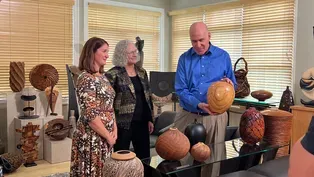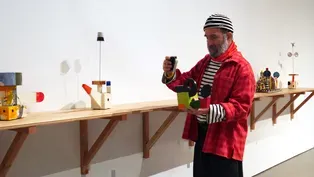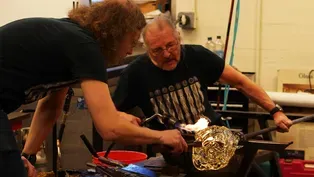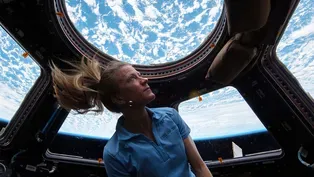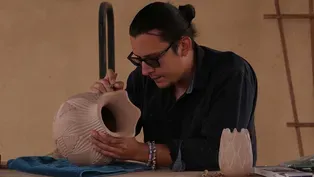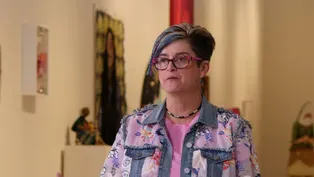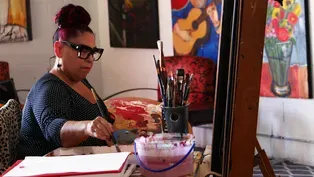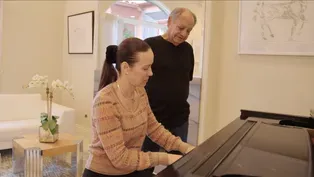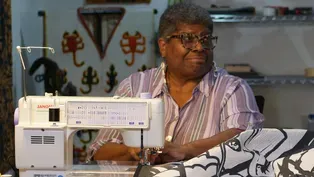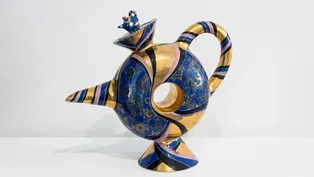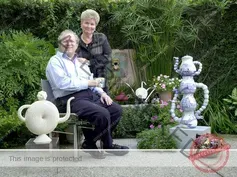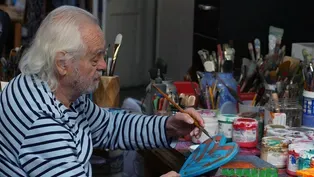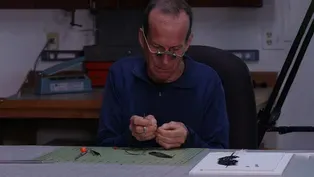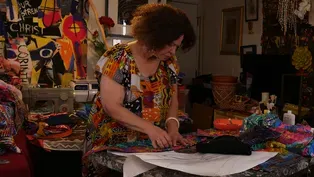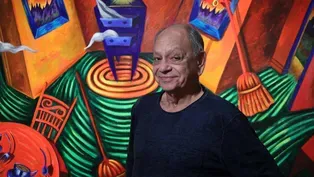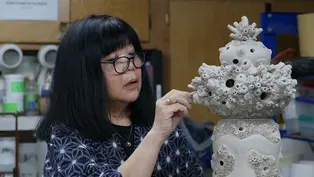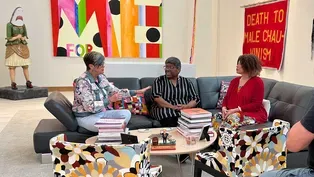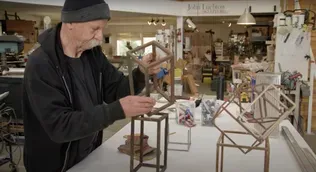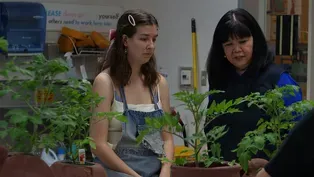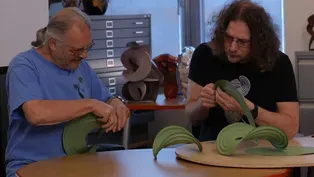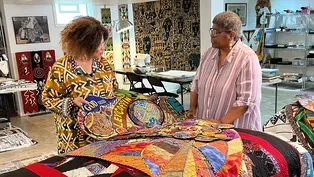
Potters Joseph & Sergio Youngblood Lugo segment
Clip: Season 16 | 9m 5sVideo has Closed Captions
Santa Clara Pueblo potters Joseph & Sergio Youngblood Lugo use ancestral techniques in their work
The Santa Clara Pueblo in New Mexico has been home to a long tradition of Native potters, including brothers Joseph and Sergio Youngblood Lugo. Joseph and Sergio demonstrate the ancestral firing technique that produces their unique polished pottery. Segment from SCIENCE episode
Problems with Closed Captions? Closed Captioning Feedback
Problems with Closed Captions? Closed Captioning Feedback

Potters Joseph & Sergio Youngblood Lugo segment
Clip: Season 16 | 9m 5sVideo has Closed Captions
The Santa Clara Pueblo in New Mexico has been home to a long tradition of Native potters, including brothers Joseph and Sergio Youngblood Lugo. Joseph and Sergio demonstrate the ancestral firing technique that produces their unique polished pottery. Segment from SCIENCE episode
Problems with Closed Captions? Closed Captioning Feedback
How to Watch Craft in America
Craft in America is available to stream on pbs.org and the free PBS App, available on iPhone, Apple TV, Android TV, Android smartphones, Amazon Fire TV, Amazon Fire Tablet, Roku, Samsung Smart TV, and Vizio.
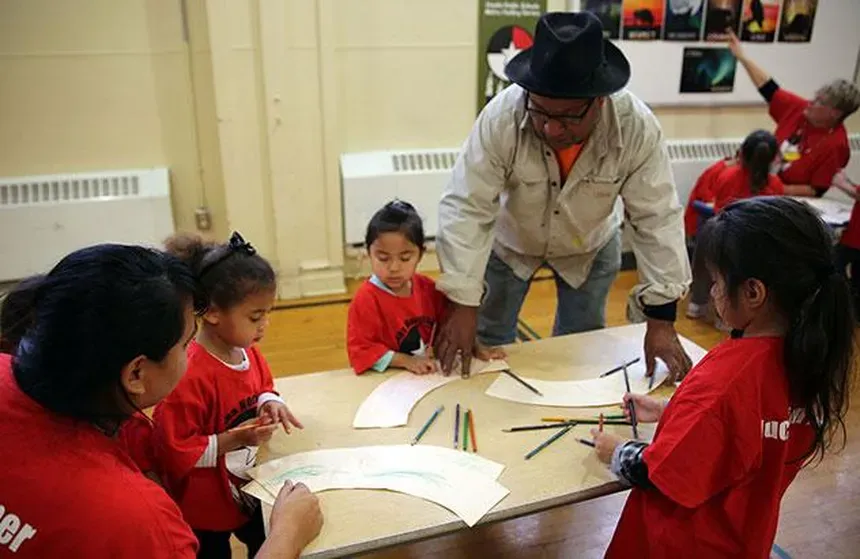
Education Guides
Download Craft in America education guides that educate, involve, and inform students about how craft plays a role in their lives, with connections to American history and culture, philosophies and science, social causes and social action.Providing Support for PBS.org
Learn Moreabout PBS online sponsorshipPottery is such an integral part of our family.
And things like where to dig for clay and \ the polishing method, how to fire pieces, those traditions have been in our family every single generation for the last thousand years.
I knew it was important when I went on a field trip to a museum and my mom's pot was in there and her mom's pot and my great grandmother's pot and my teacher was like, oh my goodness, that's your family?
Sergio and Joseph are brothers.
They come from Santa Clara Pueblo.
Each pueblo has a different style of pottery that they traditionally make and it really is based on the type of clay that is in the surrounding area.
New Mexico has so much variety and types of clay.
What is that?
Oh, that's cool.
Yeah.
So, this is really pigmented stone.
So, this we would pulverize to make slip.
And we'll find different color ones, and that's why you get variations of different types of reds.
I've been working with clay since I was about three.
I was told by everybody, you're gonna be making pottery.
It's, it's kind of, it's expected.
When we build the pots, we use what we call a puki, and it's basically just a premade bowl.
It's all coil built.
And a lot of the process is dependent on the weather.
You don't want it to be humid, because if your piece is too wet, it will collapse.
It won't be strong enough to hold its own weight.
But if a piece dries out too much, the coil will crack.
A lot of it is just feel and knowing from experience.
Joseph Lugo, his pieces are thoughtful.
And he really thinks about pueblo culture, Santa Clara culture in particular, as the foundation for the pieces that he makes.
Unlike pretty much every other tribe, we make our pieces very thick.
So we are able to carve very, very deep and create a lot of dimension.
I had my first show when I was seven years old.
It wasn't something I really wanted to do.
And I took a break for a very long time.
And one day, I just, I fell in love with it again.
It's really cool to show people what you can create with your hands.
Sergio Lugo is part of this younger generation that take traditional aspects of the work and make it part of their contemporary world.
The avanyu, or the water serpent, is a protector of water.
I created my own water serpent.
I wanted to make it more modern.
I've always thought that polishing is the most technically difficult part.
We're using just basic materials, a mixture of clay and water to make slip and polishing stones.
No glaze at all.
Everything's traditional method.
We all use in the family our grandmother's, grandmother's, grandmother's stone.
And just knowing that it's passed so many hands, it gives me a lot of confidence to do the same thing that they did.
At Santa Clara Pueblo, the people were farmers.
So, typically the women made pottery.
Men might paint or design pieces, but they didn't necessarily make pottery.
Pottery was meant for utility and for ceremony.
But in the late 1800s, when the railroads were developed, they would stop at every pueblo, and there would be people selling pottery.
About 50 years ago, the men began to make pottery as well.
Generational knowledge is passing information from person to person.
One person that did a lot of that was my great, great grandmother, Serafina Tafoya.
She had different types of impressed pieces, painted pieces.
Then she was a massive influence to the next generation after her, especially my great grandmother, Margaret Tafoya.
Margaret Tafoya is one of the most important pueblo potters of the past century.
She's one of the few potters that won best of show twice in Santa Fe Indian Market, two years in a row when she was already in her 80s.
So they come from a lineage of extraordinary potters.
Joseph and Sergio's mother, Nancy Youngblood, is also one of the leading potters working today.
We still ask her for input, all three of us, my brothers.
She's taught us to make everything handmade, hand carved, hand polished, traditionally fired.
It is a cultural science that is about pueblo life, pueblo art.
And it's all learned knowledge.
That's something that we're starting to understand is a really important part of science today that 50 years ago we didn't even think was scientific.
There's so much time and effort you put into a piece of pottery that you don't want to lose it to the wind or a major temperature change.
My mom created this shed to control all of that.
Each pot is red before the firing.
And the firing dictates if the pot is black or red.
When we started the fire, the pieces were getting sooty.
Once we put the boards on, the fire gets really hot and all of that soot starts to burn off.
You have to look in and see exactly when the soot is burning off the piece.
Yeah, still sooty on Joe's.
If it gets over fired, the piece will dull out.
It's starting to burn off here too.
Oh yeah.
When it reaches that perfect temperature, the finish is very shiny.
Yeah, my pot's done.
Once it kind of reaches that molten stage, that's when we cover it with manure.
This shredded manure keeps all of the smoke inside.
Beautiful.
That's how the color change is happening.
It's a chemical reaction of the manure and all of the smoke.
We've covered the fire now, cutting off the oxygen.
If you didn't cut off the oxygen, the pieces turn brown.
And they're just sitting in like a cloud of smoke right now.
Let's get it nice and packed.
Just making sure that temperature goes down slowly is the key to a successful piece.
We don't know the scientific detail of it, but we know what happens when you do certain things, and we know it works.
Wipe it a little bit.
It's a whole lot of work, but when it comes together, it, it's magical.
After everything's clean, we got to sign the wall.
You know, I look around and I see dates and history and relatives.
I can add my name to that.
And keep it going.
I think that 500 years ago they would have had no idea that we would still be doing this.
But it is because of the resilience that they had that we have continued to pass it through every generation.
Wood objects in Fleur, Judy and Jeff's collections
Video has Closed Captions
See more objects in Fleur Bresler's and Judith Chernoff and Jeffrey Bernstein's collections (4m 14s)
Video has Closed Captions
Learn more about Peter Shire's art and career. Bonus video from COLLECTORS episode (6m 29s)
See more of Erik and Martin Demaine's sculptures
Video has Closed Captions
Father-son team make unique curved-crease origami sculptures and incorporate it with glass (4m 47s)
Video has Closed Captions
Joseph & Sergio Youngblood Lugo on bear paw symbols in Santa Clara Pueblo pottery (2m 3s)
Quilt artist Karen Nyberg segment
Video has Closed Captions
Former NASA astronaut and quilter Karen Nyberg continues to create art inspired by space and science (6m 35s)
Potters Joseph & Sergio Youngblood Lugo segment
Video has Closed Captions
Santa Clara Pueblo potters Joseph & Sergio Youngblood Lugo use ancestral techniques in their work (9m 5s)
Objects in Sara Vance Waddell's collection
Video has Closed Captions
Sara Vance Waddell on how she became a collector and shows us pieces in her collection. (5m 15s)
Meet the artists in Cheech Marin's Chicano Art collection
Video has Closed Captions
Learn more about Jaime "Germs" Zacarias, Yolanda González, and Francisco Palomares (8m 42s)
Video has Closed Captions
Pianist Natasha Marin on living with Chicano Art (1m 8s)
Learn more about the Women of Color Quilters Network
Video has Closed Captions
Learn more about Carolyn Mazloomi and the Women of Color Quilters Network (6m 38s)
Joan Takayama-Ogawa's ceramic history
Video has Closed Captions
Artist Joan Takayama-Ogawa on her mentor, Ralph Bacerra and Joan's family history in ceramics (5m 4s)
Gloria & Sonny Kamm and Peter Shire segment
Video has Closed Captions
Meet teapot collectors Sonny and Gloria Kamm and artist Peter Shire in Los Angeles. (9m 32s)
Video has Closed Captions
Chicano artist Frank Romero on his career. Bonus video from COLLECTORS episode (7m 4s)
Fleur Bresler, Judith Chernoff, Jeffrey Bernstein, Norm Sartorius segment
Video has Closed Captions
Meet three collectors Fleur Bresler, Judith Chernoff & Jeffrey Bernstein and sculptor Norm Sartorius (13m 14s)
Feather artist Chris Maynard segment
Video has Closed Captions
Chris Maynard creates intricate art from bird feathers, inspired by his love of the natural world (7m 29s)
Video has Closed Captions
This father-son team takes inspiration from their research to create curved-crease paper sculptures (10m 56s)
Cynthia Lockhart on her career
Video has Closed Captions
Fiber artist Cynthia Lockhart on her careers and how her work ended up in the Renwick's collection (6m 19s)
Cheech Marin & Chicano Art segment
Video has Closed Captions
Comedian and collector Cheech Marin introduces us to his Chicano Art collection and artists (16m 51s)
Ceramic artist Joan Takayama-Ogawa segment
Video has Closed Captions
Ceramic artist Joan Takayama-Ogawa uses her work in clay to respond to the ongoing climate emergency (8m 38s)
Carolyn Mazloomi, Cynthia Lockhart, Sara Vance Waddell segment
Video has Closed Captions
Meet artist & collector Carolyn Mazloomi, artist Cynthia Lockhart, and collector Sara Vance Waddell (10m 38s)
Astronaut turns space photographs into quilts
Video has Closed Captions
Learn about retired NASA astronaut and quilter Karen Nyberg's space textiles (2m 6s)
Video has Closed Captions
Glass sculptor John Luebtow creates monumental glass and steel installations. (10m 55s)
Artist explores the climate crisis
Video has Closed Captions
Sustainability at Otis and Joan's climate change course (2m 33s)
American Craft Council marketplace segment
Video has Closed Captions
Meet dynamic young collectors and the artists they support at American Craft Made Baltimore (3m 47s)
Video has Closed Captions
SCIENCE investigates the unexpected intersection between art and the sciences (1m)
Video has Closed Captions
COLLECTORS reveals the essential role that craft appreciators play in the community. (58s)
Providing Support for PBS.org
Learn Moreabout PBS online sponsorship